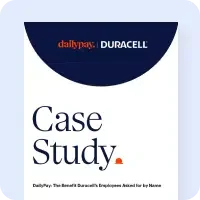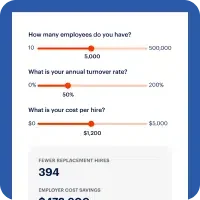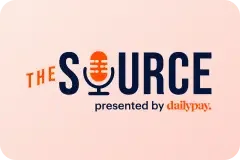Matthew Kopko, VP of Public Policy at DailyPay summarizes the CARES Act and the impacts it will have on your business and its employees. This on-demand webinar will provide:
- Easily understand the specifics about the largest financial relief package ever passed in history
- Determine how both small and large employers are able to get loans, and which loans can be forgiven
- Be aware of additional provisions on tax credits and paid leave requirements including payroll tax deferral
- Take away a solid understanding of how the CARES Act will impact your employees or recently let-go employees directly
NOTE: None of the content on this page or in this video is intended to be legal or tax advice, and should not be relied upon as such. You should consult with your own attorneys, accountants and advisors.
We’ve summarized some of the video contents below:
Coronavirus Aid, Relief, and Economic Security Act
- The bill itself is technically called the Coronavirus Aid Relief and Economic Security Act or the CARES Act. It’s also known as HR 748.
- It’s also called Phase 3 of the coronavirus response legislation (phases 1 and 2 covered immediate government disaster relief and paid leave restrictions)
Coronavirus Aid, Relief, and Economic Security Act: Overview
- But first let’s go over the CARES Act. This is the overview of the general sections of the CARES act. Particularly, we’ll be focusing in this segment on Titles I, II, and IV because they include the provisions that are most relevant to employers and contain the marquee programs relevant to the private markets. There are additional sections of the act, for example, Title III, which includes a lot of information on improvements to the healthcare system in the fight against the coronavirus
- And also Title V, which has a coronavirus relief fund, including grants to hospitals, airlines and other types of programs. There are other miscellaneous provisions as well but, again, we’ll be focusing on the loan and other programs that are relevant to employers and workers.
- So first let’s get into Title I.
Title I: Keeping American Workers Paid & Employed Act: Overview
- Is commonly called the small business loan section. It’s also called the Keeping American Workers Paid and Employed Act
- This is the marquee $350 billion loan program and, in general, the goal here is to provide loans to small companies so that they can keep operating and keep their workers on payroll during this crisis.
- And to effectuate that, not only is it a favorable government loan, but it is a forgivable loan to the extent you keep your employees hired, or rehire them by June 30th, and use loan proceeds to pay eligible expenses like payroll, rent and utilities.
- Another interesting feature of this program is the fact that it’s not issued directly by the government, but instead through a partnership with the private financial markets. So, instead of applying to the Small Business Administration, you would apply to one of many major local banks to be able to get access to this loan program.
Title I: Who is Eligible
- First let’s talk about who is eligible. Again, this is called the small business loan program, so generally small businesses are eligible. This is defined as businesses that generally employ 500 or fewer employees.
- One major exception, which impacts a particularly hard-hit segment of the economy during this crisis, are hotels and restaurants and similar businesses who classify themselves under NAICS Code 72. For them, even if they have more than 500 employees, they will still be eligible to the extent that they have no more than 500 employees in any single location.
Title I: Loan Size
- The general rule of thumb under the small business loan program in Title 1 is that you’re entitled to a loan of approximately 2.5 times your average prior monthly payroll capped, in any event, at $10 million.
- For most businesses, it’s defined as the average monthly payroll for the 12 months prior to when the loan is made. There are exceptions for seasonal employees or recently created businesses that have different time periods for measuring prior average monthly payroll.
Title I: Borrower Requirements
- Borrowers requirements are very minimal and there is explicit increased eligibility in the Act itself but borrowers will need to be able to certify in good faith that the loan is needed because of the coronavirus pandemic; that the funds will be used for eligible loan purposes for payroll, mortgages, lease rental payments and utilities; that they do not have any double-dipping applications pending before the government; or that they are not receiving any duplicate payments.
Title I: Eligible Use of Proceeds
- If you’re successful in getting a loan, there are only certain types of things that the loan can be used to pay. The most critical item is, of course, payroll costs.
- A couple things to note about the payroll cost requirements are that they include all forms of employee compensation, not just wages. So, that would include salaries, commissions, severance, leave or other types of compensation arrangements. But for any individual employee they are capped at $100,000 per year, on a prorated basis. So, that means to the extent you have employees earning more than $100,000 in a given year, you are able to use the proceeds to pay their compensation up to $100,000 and, after that, they would not be an eligible expense with the loan proceeds.
- Additionally eligible use of proceeds include certain group benefits like healthcare, interest on any mortgages related to the business, rent payments for your office space or other facilities, utilities, and, also important, interest on any existing debt obligations.
Title I: Loan Forgiveness/Deferral
- Most critical to this loan program is the concept of loan forgiveness. In essence, if you are able to manage this loan process effectively, either a large portion or potentially all of the loan you get will be able to be forgiven by the federal government and you will have no liability to repay the loan.
- Loan forgiveness is provided under the Title I program for eligible costs of payroll, interest on mortgages, rent and utility payments. Again, the restrictions on $100,000 per employee apply, but to the extent you are paying payroll, interest, rent or utilities, and you can document those payments, you are able to get forgiveness to the extent of those payments and potentially get forgiveness of the entire loan.
- If you fire people during this process and your average FTEs shrinks during the period you have the loan and afterward, the amount of forgiveness will be reduced relatively to the number of employees you have currently, as opposed to the number of employees that you had right before the pandemic hit. Similarly, to the extent you cut wages of your employees by more than 25%, you also have reduced forgiveness benefit.
- The program also includes loan deferral. Applicants are presumed to be entitled to at least a six-month deferral of all payments, fees, principal and interest. That can be expanded up to 12 months, but it’s going to be at the discretion of the Small Business Administration and your lender.
Title I: Documentation for Loan Forgiveness
- When it comes time to seek the actual loan forgiveness, be sure to keep good records, because your lender and the government will require documentation showing how many employees you have and pay stubs and pay rates to ensure that the payroll payments qualified under the restrictions under the loan program. So, you’ll be able to keep your IRS pay stubs and other type of critical payroll documentation to show payroll payments.
- Additionally, to the extent there are other qualified expenses, like rent, mortgages or utility payments, you will have to document that as well. On top of all of this, a business executive will have to certify that the documentation is true and correct and not fraudulent, and that the loan was actually used to make eligible expenses such that forgiveness is legitimate.
- As always, the government provides a provision that allows the government to request any additional information, and this case is no separate.
Title II: Relief for Workers Affected by Coronavirus Act
- Title II is the section that covers individual benefits and business tax relief. As you’ll see in Subsection A and B, these are some of the most well-known programs that have been reported by the press. They include the $1200 and $2400 checks given to individuals and also the unemployment insurance top off.
- Through the coronavirus stimulus bill, the federal government is expanding unemployment insurance by adding a federal increase of $600 per week on top of state benefits.
- Additionally, since most independent contractors and gig workers are typically ineligible for unemployment assistance, this bill allows such contractors to be able to be eligible for assistance through the unemployment insurance provisions of this bill.
- In Subsection B, large numbers of Americans will be able to get $1200 checks, per individual, and $500 checks, per child, as critical spending money to get them through this crisis.
- To the extent you earn $75,000 or less, you will get the full check and the check will be phased out between $75,000 to $99,000, such that anyone earning more than $100,000 will not be entitled to get any of these payments.
- There are also other tax provisions that have been modified through this act that are beneficial to the individual, including educational assistance provisions and relaxation of charitable contribution restrictions.
Title II, Subsection C: Payroll Tax Credit
- To the extent you’re impacted by the coronavirus pandemic, you’ll be able to get a credit of the amount of 50% after the first $10,000 per employee for employees that are impacted by the crisis. If you have less than 100 employees, all employees will be eligible, but if you have more than 100 employees, only employees that are being paid but are unable to work, will be eligible for this type of credit.
- To ensure against double dipping to the extent you take advantage of the forgivable Title I loan program, you will not be eligible for these tax credits.
Title II, Subsection C: Payroll Tax Deferral
- The bill also includes a payroll tax deferral for the tax year 2020. To the extent you’re an employer and paying payroll taxes, you will have no tax liability for payroll taxes in the year 2020, and they will instead be paid in 2021 and 2022. That means that 50% of the payroll tax obligation, instead of being due for the tax year 2020, will be due in 2021, and the other 50% will be due in 2022.
Title II, Subsection C: Other Provisions
- There are also other tax provisions that have been modified under this Title II of the stimulus bill and they include suspension of loss limitations for the Tax Cut and Jobs Act, which will impact your net operating loss provisions and mechanisms, and also a change to the corporate AMT.
- There are also other technical changes, but they are not the subject of this summary
Title IV Coronavirus Economic Stabilization Act of 2020
- In addition to the $350 billion small business loan program, there is a $500 billion loan program intended for larger employers. About $50 billion of that loan program is specifically earmarked for airlines, cargo carriers and national security-sensitive companies, or more commonly thought of as the Boeing exemption.
- The other $450 billion of the loan program is available generally to larger businesses.
- This is administered by the Treasury Secretary in coordination with the Federal Reserve and there is no loan forgiveness.
- Eligible borrowers under the large loan facility will be typically U.S.-domiciled companies with employees that are principally based in the United States.
- The loan term will be not more than five years and there are very favorable interest rates at which you’ll be able to get the loan. For the special industry loans, that is national security and airlines, the government will also require warrants to be issued in the government’s name.
Title IV: Restrictions for Borrowers
- There are lots of restrictions that come along with taking advantage of this loan program.
- Firstly, you’re not able to issue dividends or stock buybacks or other capital distributions for the duration of the loan and for a full year after.
- Secondly, you’re going to be obligated to maintain at least 90% of your existing work base as, again, the main purpose of this entire program is to ensure that workers are not fired during this crisis.
- You’re also not allowed to transfer proceeds of the loan to any offshore affiliate, and there are limitations on compensation for high-paid employees and very high-paid employees.
- There are even further restrictions to the extent you’re taking advantage of the very low interest rate loans. In addition to having to maintain 90% of your workforce you’ll have to agree to commit no outsourcing, not just for the term of the loan but for two years after, and then, importantly, you’re not allowed to abrogate any labor agreements and to the extent any labor dispute or unionization efforts spring up, you will have to maintain neutral, not just for the period of the loan but again for two years thereafter.
Title IV: Additional Airline & Banking Provisions
- There are special provisions that we won’t cover in detail that cover specifically the airlines and banks.
- Airlines, for example, are required to maintain air service in smaller communities and healthcare supply chains.
- There are a variety of changes to bank rules that allow for flexibility during this crisis.
Title IV: Consumer Forbearance
- Title IV also includes very important and valuable consumer forbearance rules.
- For customers of banks who receive loan modifications or forbearance, they will not get adverse credit reporting.
- There is also a foreclosure moratorium and forbearance on individual mortgages, which is not forgiveness of mortgage payments, but it is forbearance, and there are more restrictive and smaller forbearance for multifamily properties.
- There is a 120-day moratorium on evictions, so that people who are behind on rent payments are not going to be kicked out of their apartments during this crisis.
Phase II Bill: Coronavirus Paid Leave Requirements
- We’d also like to touch briefly on the paid leave requirements passed under the previous phase of the legislation also called Phase II.
- This was technically called the Families First Coronavirus Response Act and was passed several weeks ago and is becoming effective, April 1, 2020.
- It generally has two paid leave requirements: 1) Emergency paid sick leave and 2) Emergency Family and Medical Leave Act expansion.
- We’ll also be covering in this section one example of state laws – New York, though state reactions to the crisis vary and obligations for leave vary by state.
Coronavirus Paid Leave Requirements: Emergency Paid Sick Leave
- Emergency paid sick leave covers employers with fewer than 500 employees, who have employees who are not able to work, and who are meeting one of the six technical coronavirus-related criteria, for example, if you have to take care of your children because school closings or childcare closings have occurred.
- The paid sick leave is limited to 80 hours of paid sick leave per full-time employee and for part-timers based on recent work. So 80 hours or the equivalent of two weeks.
- For those directly quarantined by COVID-19, their regular required rate of up to $511 per day will have to be covered.
- For other people in different categories, a smaller amount, up to $200 per day, will have to be covered. And although it is controversial, healthcare employers are generally exempted from this requirement due to the work requirements in healthcare facilities at this time.
Coronavirus Paid Leave Requirements: Family Medical Leave Act
- Family Medical Leave Act Expansion generally covers employers with fewer than 500 employees and for those employees who are not able to work and who now qualify for the Family Medical Leave Act, having to care for their children because they’re out of school.
- Employees can be eligible for up to 10 weeks of Family Medical Leave following the first 10-day leave period provided for in the previous slide.
- The required amount to be paid under this part of the bill is generally 2/3 of the regular pay rate up to $200 a day and $10,000 in the aggregate.
- And again, healthcare employers are generally exempted from this requirement.
Coronavirus Paid Sick Leave Requirements in New York
- New York also passed its own leave modification requirements in the middle of March.
- It covers almost all New York employers, but those who are subject to a mandatory or precautionary order of quarantine who cannot work.
- New York employers with more than 99 employees must pay 14 days of paid leave to covered workers.
- Smaller employers have to cover 5 days of paid leave at a regular pay rate.
Key Takeaways
- Small and some not so small businesses can now get multi-million dollar loans from the federal government and potentially some, or all, of those loans can be forgiven.
- Large employers are also able to get loans, but they must maintain their workforce and there is no forgiveness.
- There are a variety of tax credits as well and a payroll tax deferral for employers.
- This bill also includes the well-known stimulus check provisions that provide direct checks to individuals and substantial grant programs for hospital, airlines and other industries.
About DailyPay
- DailyPay is a major way to preserve employee financial health and wellness in the long and short term.
- By providing our on-demand pay benefit, partners across the country have been supporting their employee financial wellness and increasing retention of their employees.
- Employers across the economy love being able to provide their employees the benefit to be paid daily instead of once or twice a month when it’s convenient for their employer.
If you’d like to be able to offer DailyPay to your employees, and take advantage of all the fee waivers and other benefits we are offering to workers during this crisis, please reach out to our team. We’d love to work with you and we’d love to bring you and your employees into the DailyPayNation. Thank you very much.
COVID-19 Notice: DailyPay has waived all next-day transfer fees so that employees can access their earned and unpaid earnings when they need it, until further notice. We are committed to getting your company up and running as quickly as you’re willing to move, so reach out to our team at joinus@dailypay.com today.













